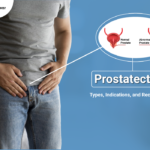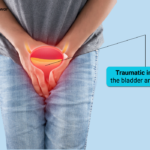In the intricate domain of male reproductive health, a condition known as undescended testicles, or cryptorchidism, emerges as a poignant struggle. It refers to the failure of one or both testicles to descend into the scrotum, disrupting the delicate harmony of the male anatomy. This blog delves into the profound significance of undescended testicles, unveiling the dire consequences that may unfold if left untreated. Early detection serves as a beacon of hope, shedding light on the urgency of timely intervention. Unraveling the enigmatic cryptorchidism causes, we unravel the intricate tapestry woven by hormonal imbalances, genetic predisposition, and anatomical deviations. Undescended testicle surgery emerges as a pivotal milestone on the path to restoration, and its methods and outcomes are poised to be explored.
Table of Contents
1. The Normal Process of Testicular Descent
During fetal development, the testicles form within the abdomen and gradually migrate downward into the scrotum. This descent is a crucial step in the development of the male reproductive system, typically occurring by the time of birth or within the first few months of life.
2. Anatomy of the Male Reproductive System and the Role of Testicles
The male reproductive system consists of various intricate structures that work in harmony to facilitate reproduction. The testicles, essential components of this system, are responsible for the production of sperm and the secretion of testosterone, the primary male sex hormone. These small, oval-shaped organs are nestled within the scrotum, suspended outside the body.
3. Significance of Testicles Being Located in the Scrotum
The positioning of the testicles in the scrotum is not merely a matter of aesthetics. The scrotum serves as a protective sac, maintaining an optimal temperature for sperm production. This external placement aids in cooling the testicles, as the internal body temperature is generally too warm for efficient sperm development. By residing in the scrotum, the testicles are better equipped to fulfill their crucial reproductive functions.
4. Prevalence of Undescended Testicles in Newborns and Young Boys
In the vast expanse of newborns and young boys, undescended testicles, known as cryptorchidism, emerge as a prevailing concern. This condition, characterized by the failure of one or both testicles to descend into the scrotum, affects a notable portion of the male population at birth and during early childhood.
According to studies, the prevalence of undescended testicles varies across populations, with estimates ranging from 2% to 9% of full-term male newborns. The incidence is even higher in preterm infants, affecting approximately 30% of those born before 32 weeks of gestation.
Moreover, the condition tends to resolve spontaneously within the first year of life in about 70% of cases. However, if undescended testicles persist beyond this timeframe, the likelihood of spontaneous descent decreases significantly, necessitating further evaluation and potential intervention.
5. Risk Factors Associated with Undescended Testicles
Within the intricacies of cryptorchidism causes lie a constellation of risk factors that cast a shadow of uncertainty over the descent of the testicles. Premature birth, with its fragile timeline, emerges as a prominent risk factor, as the testicles may not have had sufficient time to complete their journey to the scrotum. Low birth weight, a delicate indicator of early vulnerability, also contributes to the increased likelihood of undescended testicles. Furthermore, genetic factors intertwine with destiny, as familial history and inherited traits play a role in shaping the course of testicular descent.
6. Impact of Environmental Factors and Maternal Health
In this harsh landscape, environmental factors and maternal health cast their shadowy influence over the development of undescended testicles. Exposure to certain environmental pollutants and endocrine-disrupting chemicals can disrupt the delicate dance of hormones, potentially affecting testicular descent. Maternal health, a vital force in the symphony of life, holds sway over the journey of the testicles. Maternal smoking during pregnancy, for instance, has been linked to an increased risk of cryptorchidism, revealing the far-reaching consequences of maternal choices.
7. Hormonal Imbalances and Testicular Descent
Deep within the recesses of the male reproductive system, intricate hormonal symphonies orchestrate the dance of testicular descent. Hormonal imbalances can disrupt this delicate harmony, impeding the migration of the testicles. The hormone gonadotropin-releasing hormone (GnRH), produced by the hypothalamus, triggers the release of luteinizing hormone (LH) and follicle-stimulating hormone (FSH) from the pituitary gland. These hormones, in turn, stimulate the production of testosterone and guide the descent of the testicles. Any disruption in this hormonal cascade can hinder the proper positioning of the testicles within the scrotum.
8. Anatomical Abnormalities and Hindered Descent
Within the labyrinthine pathways of the male reproductive system, the presence of anatomical abnormalities can cast a dark shadow over the journey of the testicles. Structural irregularities, such as a shortened spermatic cord or abnormal positioning of the inguinal canal, can obstruct the descent of the testicles. This hindrance leads to their incomplete migration, leaving them trapped within the abdomen or along the path to the scrotum.
9. Genetic Factors and Cryptorchidism
In the realm of hidden truths, genetic factors emerge as clandestine agents, shaping the destiny of undescended testicles. Certain medical conditions carry a heightened risk of cryptorchidism, shedding light on the intertwined nature of genetics and testicular descent. Klinefelter syndrome, characterized by an extra X chromosome (XXY), disrupts the delicate balance of sex chromosomes, contributing to the prevalence of undescended testicles. Likewise, congenital adrenal hyperplasia, an inherited disorder affecting hormone production, can interfere with the hormonal cues necessary for proper testicular descent.
10. Navigating the Treatment Path for Undescended Testicles
Within the cryptic landscape of undescended testicles, treatment options emerge as beacons of hope, guiding individuals toward restoration and reclaiming the balance of masculinity. From hormone therapy to surgical interventions, a range of approaches are available, each carrying its own benefits and limitations.
Hormone Therapy:
Hormone therapy involves the administration of gonadotropin-releasing hormone (GnRH) analogs to stimulate testicular descent.
Benefits:
- May trigger testicular descent in some cases, particularly if hormonal imbalances were the primary cause.
- Non-invasive approach, avoiding the need for surgery.
Limitations:
- Success rates vary, and it may not be effective in all cases.
- Requires prolonged treatment duration and regular follow-up to monitor progress.
- Limited effectiveness for certain types of anatomical abnormalities or genetic factors.
Surgical Interventions (Orchidopexy):
Orchidopexy, the surgical repositioning of the undescended testicle into the scrotum, is a commonly employed treatment for undescended testicles.
Benefits:
- Provides a definitive and long-lasting solution.
- Corrects anatomical abnormalities and ensures proper positioning of the testicles.
Limitations:
- Requires anesthesia and carries the inherent risks associated with surgery.
- Recovery period and potential complications such as infection or bleeding.
- Success rates may vary based on factors such as the age of the patient, the location of the testicle, and previous failed treatments.
Recommended Age for Treatment Initiation:
- Treatment for undescended testicles is typically initiated during early childhood.
- Orchidopexy is recommended between 6 and 18 months of age.
- Early intervention allows for optimal outcomes by maximizing the potential for spontaneous descent and minimizing potential complications associated with prolonged undescended testicles.
Conclusion
In the vast expanse of undescended testicles, the path to restoration and rejuvenation is revealed through a careful exploration of available treatments. From hormone therapy to surgical interventions like orchidopexy, the enigma of cryptorchidism begins to unravel. Hormone therapy, with its potential benefits and limitations, offers a glimmer of hope, while surgical interventions provide a definitive solution. Early initiation of treatment, guided by the wisdom of medical professionals and urology doctors like Dr. Dushyant Pawar, unlocks the potential for favorable outcomes, allowing individuals to reclaim the symphony of masculinity that was once concealed



